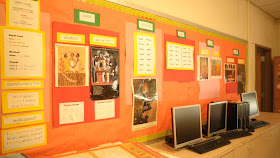I've written earlier about my oral Warm Ups for my art class. Well, today I will tell you about my written Warm Ups.
Most of my Warm Ups are based on the Principles and Elements of Design, which are all posted on my word wall in the back of my room.
I write which Element or Principle I want the students to describe or analyse on the board next to the projected art work. The art work can be any painting or sculpture visual that you have.
The students then fill in the grid corresponding to what I am looking for. This year I will have the students do one Element/Principle a day, collect the grid, store them in their folders and hand them back the next day. We'll go over the answers on Friday, I'll collect them and give them a weekly grade.
I am trying to save paper. Last year, I did the Warm Ups daily with the students got a new grid every day.
It took a lot of paper!
How do you do Warm Ups in your art room? Do you have a Warm Up that works for you?










